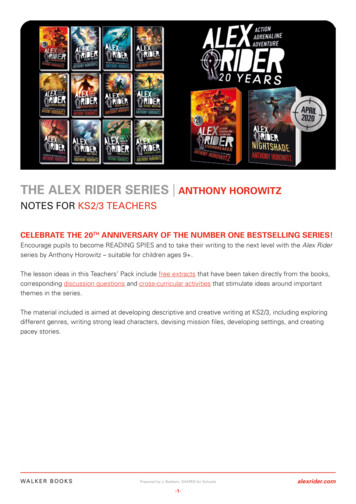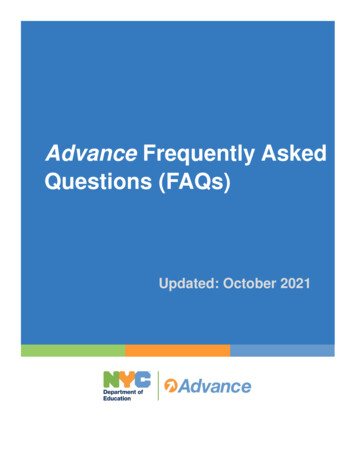
Transcription
THE ALEX RIDER SERIES ANTHONY HOROWITZNOTES FOR KS2/3 TEACHERSCELEBRATE THE 20TH ANNIVERSARY OF THE NUMBER ONE BESTSELLING SERIES!Encourage pupils to become READING SPIES and to take their writing to the next level with the Alex Riderseries by Anthony Horowitz – suitable for children ages 9 .The lesson ideas in this Teachers’ Pack include free extracts that have been taken directly from the books,corresponding discussion questions and cross-curricular activities that stimulate ideas around importantthemes in the series.The material included is aimed at developing descriptive and creative writing at KS2/3, including exploringdifferent genres, writing strong lead characters, devising mission files, developing settings, and creatingpacey stories.WA L K E R B O O K SPrepared by J. Baldwin, SHAPES for Schools-1-alexrider.com
ABOUT THE BOOK: STORMBREAKER 20th ANNIVERSARY EDITIONThe first action-packed adventure that started the number one bestselling Alex Rider series.In the first book in the number one bestselling Alex Rider series by Anthony Horowitz, fourteen-year-oldAlex is forcibly recruited into MI6. Armed with secret gadgets, he is sent to investigate Herod Sayle, a manwho is offering state-of-the-art Stormbreaker computers to every school in the country. But the teenage spysoon finds himself in mortal danger.**It’s time for your first assignment . . . Are you ready for your secret mission?**LESSON IDEA ONE INTRODUCING THE SERIESOBJECTIVE: To understand and be able to list the features of different genres in fiction.LEAD-IN QUESTIONS: Let’s find out . . .– What do you know about the Alex Rider series? What genre of story do you think they fall into?– What does the cover of Stormbreaker make you think about? What sort of story do you think this might be?TASK 1:In pairs, read out the opening sentence of Stormbreaker:“When the doorbell rings at three in the morning, it’s never good news.”1. How does the sentence draw the reader in?2. Does it create a feeling of mystery or adventure? How?3. Can you pick out effective words and phrases that create atmosphere in the sentence?4. Does the opening sentence make you feel that something important might happen next? How?TASK 2:Predict what might happen after this sentence. Share your ideas with a partner!TASK 3:Cut out the genre cards below. For each of them, think of an example of a book that fits into that particulargenre. One of the cards has been left blank for you to come up with your own! Is it possible for a book to fitinto more than one genre?ADVENTURECOMEDYFANTASYROMANCEWA L K E R B O O K SPrepared by J. Baldwin, SHAPES for Schools-2-SPYalexrider.com
TASK 4:The Alex Rider series that we will be using in this resource pack fits into both the “adventure” and “spy”genres. Can you predict why? Working in pairs, create a list of six features of the adventure and spy genres.Give reasons for your choices. Use the example below to get you started! A mystery to be solved . . .TASK 5:Finally, choose one of the Alex Rider books listed below. Using the title and your knowledge of genre,create an exciting book cover to represent what you think the story is about. Remember the followingsuccess criteria when creating a book cover: a bold design, strong colours, and a clear title.STORMBREAKERPOINT BLANCSKELETON KEYEAGLE STRIKESCORPIAARK ANGELSNAKEHEADCROCODILE TEARSSCORPIA RISINGRUSSIAN ROULETTENEVER SAY DIESECRET WEAPONWA L K E R B O O K SPrepared by J. Baldwin, SHAPES for Schools-3-alexrider.com
TOP SECRET:MY ALEX RIDER BOOK COVERWA L K E R B O O K SPrepared by J. Baldwin, SHAPES for Schools-4-alexrider.com
LESSON IDEA TWO A COURAGEOUS CHARACTEROBJECTIVE: To create a character profile for a fictional character.LEAD-IN TASK: Let’s read!Read the following extract from Stormbreaker:He rolled out of bed and walked over to the open window, his bare feet pressing down thecarpet pile. The moonlight spilled on to his chest and shoulders. Alex was fourteen, already wellbuilt, with the body of an athlete. His hair, cut short apart from two thick strands hanging over hisforehead, was fair. His eyes were brown and serious. For a moment he stood silently, half-hiddenin the shadow, looking out. There was a police car parked outside. Fromm his second-floorwindow Alex could see the black ID number on the roof and the caps of the two men who werestanding in front of the door. The porch light went on and, at the same time, the door opened.What can you tell about Alex’s character from this extract? Discuss it with the person next to you and shareyour ideas with the class.TASK 1:Look at the character wheel below. Using the wheel, can you describe Alex as he is portrayed in the extract?Alternatively, can you describe yourself or an imagined character? Make notes in each segment of the wheel.IOTBIAPPEANSRANAMAGEENDS/FRIYILCEAMCHARACTER WHEEL:FWA L K E R B O O K SQUALSITIES/FLAWPrepared by J. Baldwin, SHAPES for Schools-5-alexrider.com
TASK 2:When writers build characters, they have to make sure that all of the elements of the character wheel arecovered in detail. In order to achieve this detail, it might be helpful to create further wheels for each of thecategories. For example, look at the wheel below for ‘Character Qualities/Flaws’. Can you use it to go intomore detail when describing yourself or your imagined character?CHARACTER WHEEL:ALHONEST/DISHOIDNFREFULUN/TENR E C K L E S S / CACERTAI NEXCIESTTABE/UNIONTOEMONLQUALITIES/FLAWSCBRAVE /COWARDLYTASK 3:Add some segments to the Qualities/Flaws wheel. Alternatively, create a new wheel for one of the othercategories from the first Character Wheel. Go into as much detail as possible about your character – the morethe better! Once you’ve created a few wheels, use them to write a paragraph describing your character.WA L K E R B O O K SPrepared by J. Baldwin, SHAPES for Schools-6-alexrider.com
LESSON IDEA THREE COURAGEOUS CHARACTEROBJECTIVE: To create a storyboard for a new secret mission.LEAD-IN TASK: Let’s become story spies! First of all, push all the tables and chairs to the perimeter of the classroom – giving you space to movearound. Transform each table into a different “station” or “checkpoint”. On each checkpoint, put a single, coloured sheet of paper, a “feeling card” with an emotion written on it,and a different classroom object (e.g. a rubber, a ruler, a whiteboard pen, an exercise book). When everything is set up, walk around the room and make creative connections between (even themost mundane) objects, colours and feelings. Do they spark any interesting ideas for a story? Once you have walked around the room, take 10–15 minutes to note down your ideas. Can you createa character for your new story, based on your own experiences during the task, or your observations ofanother classmate?TASK 1:Read the following extract from Stormbreaker:“What we’re suggesting is that you come and work for us,” Mrs Jones said. “We have enoughtime to give you some basic training – not that you’ll need it, probably – and we can equip youwith a few items that may help you with what we have in mind. Then we’ll arrange for you to takethe place of this other boy. You’ll go to Sayle Enterprises on 29th March. That’s when this Lesterboy is expected. You’ll stay there until 1st April, which is the day of the ceremony. The timingcouldn’t be better. You’ll be able to meet Herod Sayle, keep an eye on him and tell us what youthink. Perhaps you’ll also find out what it was your uncle discovered and why he had to die. Youshouldn’t be in any danger. After all, who would suspect a fourteen-year-old boy of being a spy?”1. What is Alex’s mission?2. Who is Alex spying on?3. Why does Mrs Jones think this is a good idea?4. What has happened to Alex’s uncle?TASK 2:Create a Mission File for Alex. Note down all of the important information that he needs to remember intobullet points. Draw pictures of anyone he needs to look out for!WA L K E R B O O K SPrepared by J. Baldwin, SHAPES for Schools-7-alexrider.com
TASK 3:Create your own Secret Mission for Alex or for the character that you created in the previous lesson. Makean original Mission Storyboard showing how the mission should progress.For example, in the first box you might draw a character or scene at the beginning of the mission. Considerwhether it includes a crime scene, or even a person wondering how to get revenge. Use words andillustrations to tell the story of your mission.MY MISSION: STORYBOARDWA L K E R B O O K SPrepared by J. Baldwin, SHAPES for Schools-8-alexrider.com
LESSON IDEA FOUR SETTING THE SCENEOBJECTIVE: To describe a new setting using sensory description.LEAD-IN QUESTIONS: Let’s find out . . .– What are your favourite settings to read about?– Why is it important to have a strong setting?TASK 1:There are lots of brilliant settings in the Alex Rider series. For example, read the one below taken fromStormbreaker:London appeared.Suddenly the clouds rolled back and the midday sun brought the whole city, shining, intoview. There was Battersea Power Station, standing proud with its four great chimneys still intact,even though much of its roof had long ago been eaten away. Behind it, Battersea Park appearedas a square of dense green bushes and trees that were making a last stand, fighting back theurban spread. In the far distance, the Millennium Wheel perched like a fabulous silver coin,balancing effortlessly on its rim. And all around it, London crouched; gas towers and apartmentblocks, endless rows of shops and houses, roads, railways and bridges stretching away on bothsides, separated only by the bright silver crack in the landscape that was the River Thames.Alex saw all this with a clenched stomach, looking out through the open door of the aircraft.He’d had fifty minutes to think about what he had to do. Fifty minutes while the plane dronedover Cornwall and Devon, then Somerset and the Salisbury Plains before reaching the NorthDowns and flying on towards Windsor and London.For the extract:1. Underline any powerful words that stand out to you.2. Underline as many ADJECTIVES as you can.3. Underline as many ADVERBS as you can.4. Underline any SIMILES and METAPHORS.TASK 2:Write each of the five senses (sight, sound, smell, touch, taste) on five different sheets of paper. In pairs,make a list of key words/phrases or adjectives that appeal to the senses in the extract. Write down all ofyour key words/phrases on the corresponding sheet of paper.Consider how each word or phrase that you have written down is effective. How does it make you feel?What does it make you think of? Can you draw London based on the description in the extract?TASK 3:Now, imagine a setting of your own. It can be a real place, a city just like in the extract, or somewhere in yourimagination. How would you use sensory description to write about your chosen setting? Using five newsheets of paper, note down any key words or phrases that you would use to evoke each of the five senses.WA L K E R B O O K SPrepared by J. Baldwin, SHAPES for Schools-9-alexrider.com
TASK 4:Use your notes to write five possible sentences that you might use to describe the setting that you arethinking of (one for each of the senses). Write down a sentence on each side of the story die templatebelow, adding a sixth bonus sentence, and make the die!Ask a partner to roll the die. Can they match each of your sentences to the correct sense? Share yourfavourite sentences and suggestions with the class!WA L K E R B O O K SPrepared by J. Baldwin, SHAPES for Schools-10-alexrider.com
LESSON IDEA FIVE ACTION AND ADRENALINEOBJECTIVE: To understand how to create pace and tension in writing.LEAD-IN QUESTIONS: Let’s find out . . .– What is pace? Why is pace important in an adventure story?– How does increasing pace in a story make the reader feel tense or “on the edge of their seat”?– Can you think of a book that you’ve read which had a moment of tension? How did it make you feel?– What is a cliffhanger?TASK 1:Read the following extract from Stormbreaker:The plane had completed its pre-flight tests. It was facing down the runway. Its propellerswere at full speed.Alex slammed the gears into first, released the handbrake and gunned the Jeep forward,shooting over the drive and on to the grass, heading for the airstrip. At the same time there wasa chatter of machine-gun fire. He yanked down on the s teering-wheel and twisted away as hiswing mirror exploded and a spray of bullets slammed into the windscreen and door. The twocars, s peeding towards him, head-on, were getting closer and closer. Each of them had a guardin the back seat, leaning out of the window, firing at him. Alex swerved between them, and for ahorrible second there was actually one on each side. He was sandwiched between the two cars,with guards firing at him left and right. But then he was through. The guards missed him andhit each other. He heard one of them yell out and drop his gun. One of the cars lost control andcrashed into the front of the house, metalwork crumpling against brick. The other screeched to ahalt, reversed, then came after him again.The plane had begun to move down the runway. Slowly at first, but rapidly picking up speed.Alex hit the tarmac and followed.His foot was pressed down, the accelerator against the floor. The Jeep was doing about seventy – not fast enough. For just a few seconds Alex was parallel with the cargo plane, only acouple of metres from it. But already it was pulling ahead. At any moment it would be in the air.And straight ahead of him, the way was blocked. Two more Jeeps had arrived on therunway. More guards with machine-guns balanced themselves, half-crouching, on the seats.Alex realized the only reason they weren’t firing was that they were afraid of hitting the plane.But the plane had already left the ground. Ahead of him, and just to his left, Alex saw the frontwheel separate itself from the runway. He glanced in his mirror. The car that had chased himfrom the house was right on his tail. He had nowhere left to go.One car behind him. Two Jeeps ahead of him. The plane now in the air, the back wheelslifting off. Everything happening at once.After reading the extract, plot the moments of tension on the graph below. Consider when the tension is atits highest and at its lowest. How does the author achieve this?WA L K E R B O O K SPrepared by J. Baldwin, SHAPES for Schools-11-alexrider.com
TENSIONEVENTTASK 2:Read the extract again. Can you find examples of the following techniques to create tension or excitementfor the reader? A variation of short and long sentences to create pace. Vocabulary to evoke an ominous atmosphere. Strong emotions from the characters. Cliffhangers.TASK 3:Now it’s your turn to plot your own scene using the same graph, but this time use a different coloured penor pencil. Consider the following things: What events will occur? How will your characters feel? How will the pace increase or decrease? What will the highest/lowest moment of tension be?WA L K E R B O O K SPrepared by J. Baldwin, SHAPES for Schools-12-alexrider.com
TASK 4:Now that you’ve plotted out your scene using the graph, it’s time to write it down! Remember to use thesuccess criteria from Task 2: varied sentence lengths; vocabulary to evoke atmosphere; strong emotionsfrom characters – and away you go!EXAMPLE OF PACE AND TENSION.WA L K E R B O O K SPrepared by J. Baldwin, SHAPES for Schools-13-alexrider.com
ALEX RIDER REFLECTION ACTIVITIESUse everything you have completed in these lessons to create your own Alex Rider adventure/spy short story!With your partner, take turns to complete the following statements:– I have most enjoyed.– I have learned.– I would like to read more Alex Rider books because.– The next Alex Rider book I want to read is.**MISSION COMPLETE**Alex Rider , Boy with Torch Logo 2020 Stormbreaker Productions Ltd. Cover illustration 2020 Walker Books Ltd.WA L K E R B O O K SPrepared by J. Baldwin, SHAPES for Schools-14-alexrider.com
Armed with secret gadgets, he is sent to investigate Herod Sayle, a man who is offering state-of-the-art Stormbreaker computers to every school in the country. But the teenage spy . There was Battersea Power Station, standing proud with its four great chimneys still intact, even though much of its roof had long ago been eaten away. Behind it .











